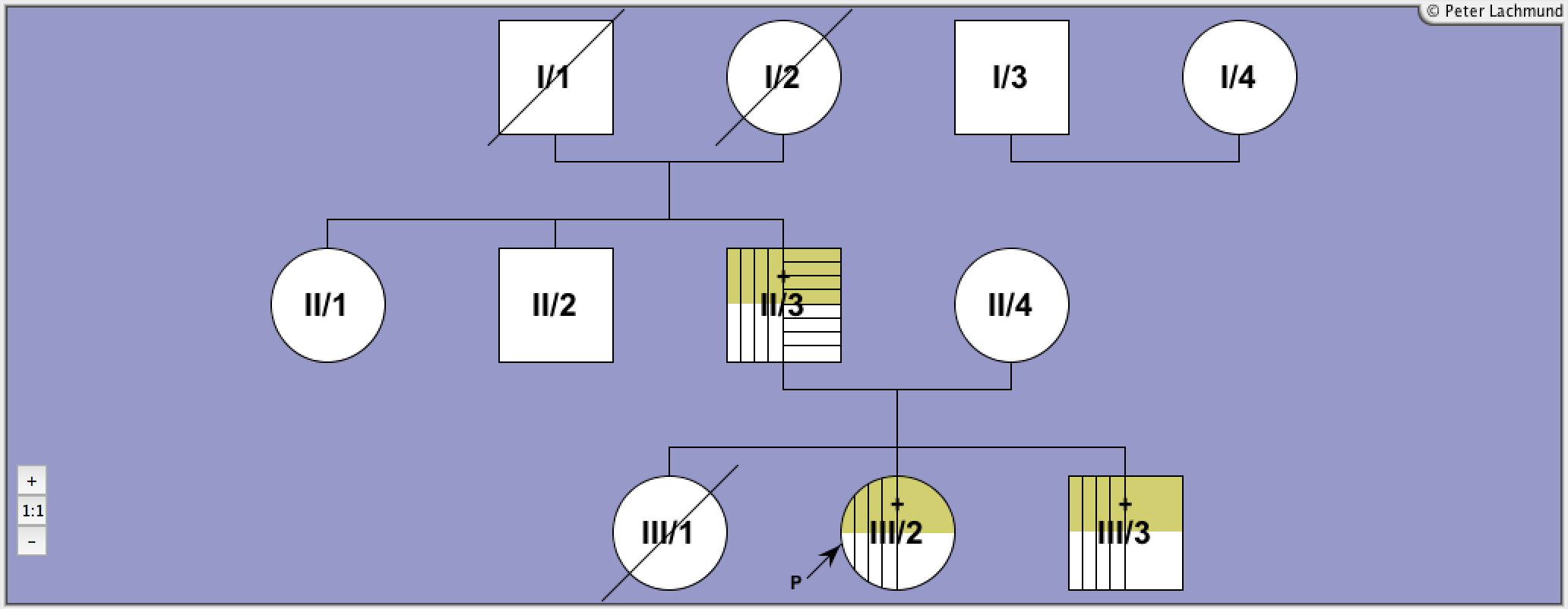Details Of Published TSH Receptor Mutation
Met 453 Thr
c.1358T>CConstitutively Activating TSH Receptor Mutation
Type
gain
Manifestation
family
Exon
10
Legend:

Male

Female

Unknown

Deceased
+
Mutation
-
No Mutation

Hyperthyroidism
(Heterozygous)
(Heterozygous)

Goiter

Relapse
P
Index Patient
Molecular Characteristics:
default
Clinical Features:
diagnosis:
III/2: 8 months (index patient), diffuse goiter
III/3: neonatal
II/3: neonatal
III/2: mild facial hypoplasia, advanced bone age, motor and speech delay
III/3: cholestatic jaundice, generalized petechial hemorrhage
III/3,2, II/2: ventriculomegaly, shortening of the 5th metacarpal bones and of the middle phalanges of the 5th finger, advanced bone age, hepatosplenomegaly, exophthalmos, scaphocephaly
1 familial activating germline mutation investigated by Supornsilchai et al. 2009
III/2: 8 months (index patient), diffuse goiter
III/3: neonatal
II/3: neonatal
III/2: mild facial hypoplasia, advanced bone age, motor and speech delay
III/3: cholestatic jaundice, generalized petechial hemorrhage
III/3,2, II/2: ventriculomegaly, shortening of the 5th metacarpal bones and of the middle phalanges of the 5th finger, advanced bone age, hepatosplenomegaly, exophthalmos, scaphocephaly
1 familial activating germline mutation investigated by Supornsilchai et al. 2009
Treatment:
III/2: antithyroid drugs ineffective, subtotal TE at 4yr
III/3: antithyroid drugs
II/3: antithyroid drugs ineffective, subtotal TE at 8 and 18yr, relapse of hyperthyroidism, radio-iodine therapy at 18, 21, 28yr, euthyroid thereafter
III/3: antithyroid drugs
II/3: antithyroid drugs ineffective, subtotal TE at 8 and 18yr, relapse of hyperthyroidism, radio-iodine therapy at 18, 21, 28yr, euthyroid thereafter
Functional Characteristics:
cAMP
(basal)
(basal)
cAMP
(TSH)
(TSH)
IP
(basal)
(basal)
IP
(TSH)
(TSH)
TSH-Binding
Cell Surface Expression
Prevalence
LRA
Ref
5.7-7.0
0.8
1.0
0.8-1.0
0.66
1
5.2+/-0.8
1,3,4
Legend:
cAMP (basal): basal in vitro cAMP production of mutant over wild-type TSHR
cAMP (TSH): maximal in vitro cAMP production of mutant over wild-type TSHR
IP (basal): basal in vitro IP production of mutant over wild-type TSHR
IP (TSH): maximal in vitro IP production of mutant over wild-type TSHR
TSH-binding: maximal TSH-binding compared to the wild-type TSHR
Cell surface expression: cell surface expression of mutant compared to WT-TSHR
LRA: linear regression analysis (LRA) of constitutive activity as a function of TSHR expression determined by 125I-bTSH binding or FACS analysis compared to the wild-type TSHR
Prevalence: Prevalence of (somatic and germline) activating mutations*
Ref: Reference for functional characterization
Child: Found in children.
Reference 1:
De Roux et al.
J. Clin. Endocrinol. Metab. 81: 2023-2026
A neomutation of the thyroid-stimulating hormone receptor in a severe neonatal hyperthyroidism.
1996
Reference 2:
Supornsilchai et al.
Clin Endocrinol. 70: 623-8
Expanding clinical spectrum of non-autoimmune hyperthyroidism due to an activating germline mutation, p.M453T, in the thyrotropin receptor gene.
2009
Reference 3:
Jäschke et al.
Cell Mol Life Sci 65:4028-4038
Preferences of transmembrane helices for cooperative amplification of G(alpha)s and G (alpha)q signaling of the thyrotropin receptor.
2008
Reference 4:
Lüblinghoff et al.
J Endocrinol Invest 33:228-233
Lack of consistent association of thyrotropin receptor mutations in vitro activity with the clinical course of patients with sporadic non-autoimmune hyperthyroidism.
2010

